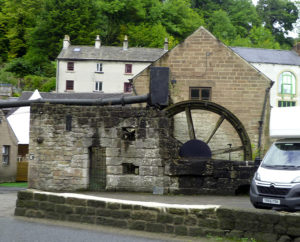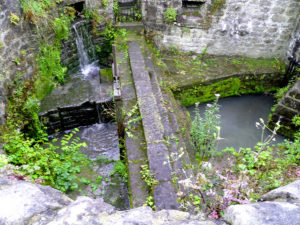Cromford is a delightful small village in the depths of the Derbyshire Dales surrounded by steep wooded hills. In the early C18th this was a tiny settlement of a few cottages and farms. It owes its development to Richard Arkwright, who built a village here for workers employed in his “mills”:http://wasleys.org.uk/eleanor/presocialhistory/socialhistory/industrial/cromford/index.html .
When Richard Arkwright opened his first cotton spinning mill, he employed local labour. As the mills expanded, he needed a larger workforce and advertised for workers with large families and offering them a house to rent.
These were among some of the first and best industrial housing to be built. They were well built houses with a toilet and garden. The top floor had large windows and was by the husband for hand loom weaving until the weavers shed was built and weaving was no longer a cottage industry.
Arkwright employed women and children in the spinning mills so wanted to encourage large families. The work was popular as it provided regular hours, money and time off. It increased the family income drastically as families were no longer dependent on the wages of the husband from weaving.
He provided shops, chapel, pubs and a school for the youngest children. He was also responsible for the market which provided a regular and reliable supply of provisions.
The village is a short walk from Cromford Mill and is popular with day visitors. At the centre is Greyhound Pond, formed by damming the Bonsall Brooke and which provided a reliable source of water for the mills. There is a pleasant walk around the pond past the Methodist Church and the remains of a C19th water mill used to grind barytes. On the opposite side of the pond is the Boat Inn and Scarthin Books, a popular second hand bookshop with a vegetarian and vegan cafe.
The splendid Greyhound Hotel overlooking the old market place was built to provide accommodation for visitors to the mills. Arkwright also used it to conduct business.
The first houses to be built by Arkwright are the two rows of terrace houses on North Street. These are solid stone built houses with the front door opening directly onto the street. Rooms were large with the best living room at the front and living kitchen behind. Each house had a large back garden.
Later houses built on Victoria Row had a small front garden.
The school at the end of North Street was built by Richard Arkwright II in 1832, Before then, the Sunday school had provided a rudimentary education for children working in the factories. The Factory Act of 1833 banned the employment of children under nine in factories. Schools provided a means of “training children in the habits of work discipline, obedience and punctuality which were required by employees”. Attached to the school was a house providing accommodation for young mill workers who were required to work under the ‘half time system’ and spend part of the day at school. The school is still there and still educating children.
Tucked away behind the housing on the main street through Cromford is what affectionately called the Bear Pit by locals. This is a stone lined pit with a dam and sluice which collected water from Cromford Sough Lead Mine. This was the source of water used by Arkwright’s first mill. As more mills were built, the Sough couldn’t supply enough water so the Greyhound Pond was built. Sough water collected in the Bear Pit and was forced by the dam into an underground tunnel to the Greyhound Pond.
Cromford is an attractive village to walk around with a small selection of local shops including a butcher and bakery as well and an antique centre and places to eat.















